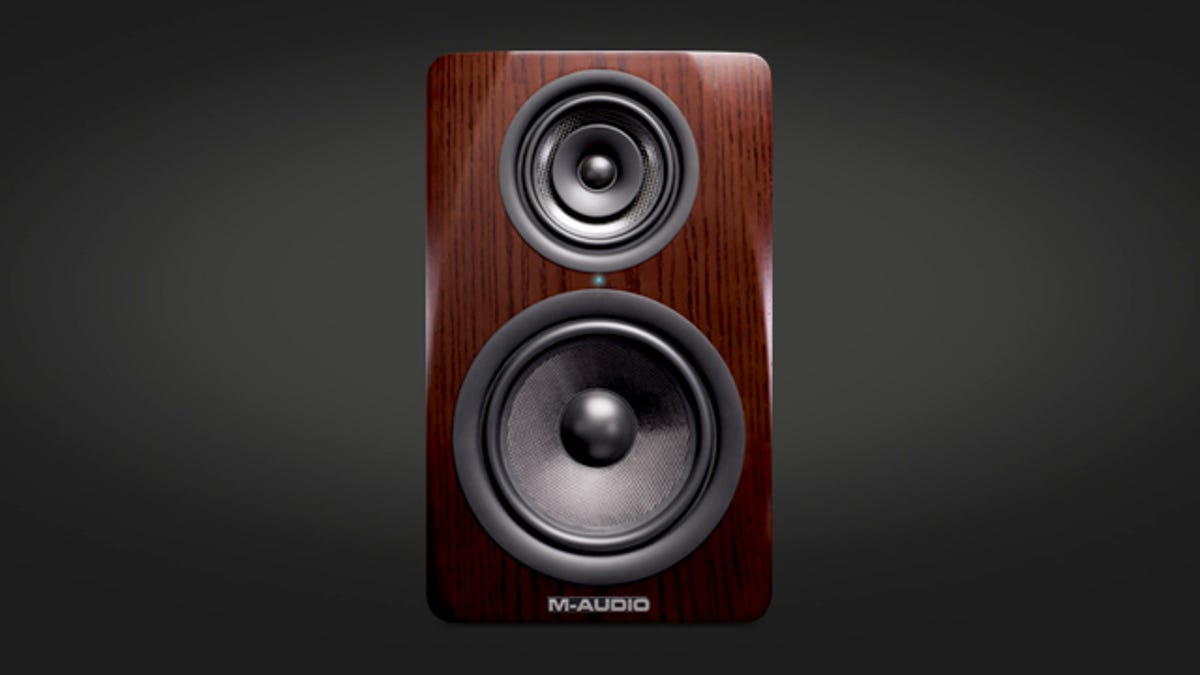Shock and awe: The M-Audio M3-8 speakers
The Audiophiliac gets bowled over by M-Audio's affordable, yet feature-packed, self-powered speakers.

I didn't know the price of the M-Audio M3-8 when I first started listening, I just assumed it was $900 to $1,000 for the pair of speakers. No, the street price is closer to $600 for a pair, around the same price as for one of the reigning wireless champions, such as the Bowers & Wilkins Zeppelin Air or Bose SoundDock 10. And the M3-8s deliver so much more of the sound of your music than those two wireless models, it's not even close. For one thing a pair of M3-8s produce stereo, and the sort of room-filling sound that a single wireless speaker can only hint at. In bass prowess, dynamic range, midrange clarity, treble detail, and volume capability the M3-8s exceed the comparably priced wireless competition by a wide margin. You could hook the self-powered M3-8s up, with the right wire, to your phone, Blu-ray player, stereo preamp, or any source with a volume control.
The M3-8 is a large, three-way bookshelf speaker. It has an 8-inch Kevlar woofer, a 5-inch Kevlar midrange, and a 1-inch tweeter, and each driver has its own built-in amplifier. The woofer is driven by a 150-watt amp, while the midrange and tweeter each get their own 35-watt amp (all three amps are Class A/B designs). The cabinet measures 10.6x17.1x11.2 inches and it weighs 28.2 pounds. Connectivity options include RCA, 6.3mm, and XLR input jacks, and the rear panel also features low, mid, and high tone controls, a volume control, and a "high-pass" switch to allow the speaker to be used with a subwoofer. A bass slot/port runs along the top of the rear panel, and while handling the M3-8s I was impressed with their rock-solid build quality.
The M3-8 was designed primarily for use in recording studios, but I had no trouble hooking it up to my stereo and two-channel home theater systems. You could build an awesome multichannel home theater setup with three M3-8s for the front left, center, and right channels, and M-Audio BX5-D2 speakers for the surround channels ($299/pair), and an Oppo BDP-105 Blu-ray player. The M3-8s' abundant bass power might preclude the need to add a subwoofer, but sure, you could add one at any time. The Emotiva UMC-200 ($599) surround processor will also be worth considering for those of you interested in building a multichannel home theater around M-Audio speakers.
Vocal sound was spot-on; there was a terrific sense of body and clear articulation to voices, things that you can't always count on in speakers in the M3-8s' price class. The M3-8s like to play loud and reward the listener with lifelike dynamics, but they sound nearly as good at more moderate volume levels. The M3-8s threw an impressively deep soundstage when I popped on Aphex Twin's "Selected Ambient Works Volume 2." Image focus and precision were excellent. Large-scale classical music sounded appropriately massive, and string tone was rich and full.
Low-end gusto is excellent; the M3-8 is a seriously powerful speaker. In my home listening room with the M3-8s 4 feet away from the rear wall I had to turn the speakers' bass EQ down a couple of notches from the "flat" setting, that's how strong it is. Electric bass instruments' snap, punch, dynamics, and power are all superb -- I know of no other speaker than can touch the M3-8 in this regard for the money. The other recent self-powered speakers I've tested were all desktop, nearfield monitors, and the M3-8 is too large to work in that setting, so I didn't directly compare it with any desktop speakers.
I really enjoyed my time with the M3-8s, but they're not for everybody. The Magnepan MMG and Tekton M-Lore speakers are more refined, more open, less boxy, and clearer-sounding speakers. Ah, but those two floor-standing speakers aren't powered, so once you add the expense of buying a receiver or power amp, the $600 MMG and $650 M-Lore wind up costing more than the M3-8s. The MMGs and M-Lores are no match for the M3-8's bass prowess and room-filling power. Alas, the search for perfection continues, but for now the M3-8 is a mighty attractive speaker for budget-minded audiophiles who like to fill fairly large rooms with high-volume sound. Of course, the M3-8 is ideal for use as a studio monitor.
One nitpick: the M3-8s' drivers, like those of a few other powered speakers I've tested, emit a small amount of hiss. You probably won't notice it when music is playing, but otherwise the noise is audible from a few feet away.

